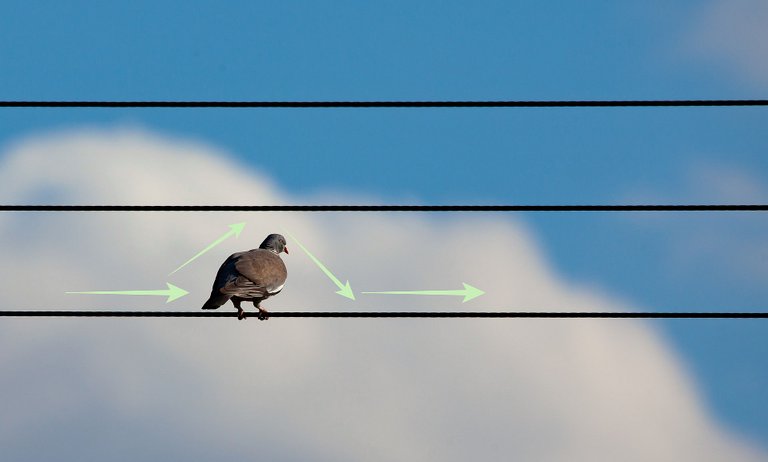Why Birds Don't Get Electrocuted/Shocked When Sitting On A Power Line
So, in our previous post where we discussed about the danger of electricity beyond voltage or current, we stated that how we position our body when in contact with electricity can also affect how it flows and how dangerous it can become regardless of high voltage or current. An example as was also stated in the post was the case of birds sitting on a power line and not getting shocked/electrocuted when the line is carrying electricity. Ever asked yourself why ?
Well, some may think or assume that the line/wire is insulated but that is very untrue. The only wire that is usually insulated is the wire that comes directly from an electrical pole to our homes and it's usually for safety. The wires we see across different electrical poles/towers aren't insulated, they are purely naked conductors and there are reasons why they left uninsulated - you can find the reasons in "Further Reading" at the end of this article.
Another assumption could be that birds are very special which would more or less imply birds can't get shocked/electrocuted by electricity. Well, this also is a false assumption, actually birds too can get shocked. However, before we proceed to explaining why birds don't get shocked and we can, we must first understand how electricity moves.
There are actually two ways of electricity moving along a conductor and they are
If the conductor is placed between the positive end and negative end of a particular electrical source.
If the conductor is placed between one of the electrodes of an electrical source and that of another source, provided the voltages are different.
The second way looks a little bit confusing but i would explain. The first way is normally how electrical gadgets operates, for example, you have a small bulb and you want it to glow. To do this, you simply place one end of the bulb to the positive side of, say a battery and the other end of the bulb at the negative side of the same battery - the circuit is complete.
The second way is the reason why we feel some kind of sensation when we place our tongue on one of the electrodes of a battery or why we get shocked when we touch a live wire (carrying electricity from the power station) - notice in this case that we are only touching one part of the source. The question now is, how does the circuit get complete for electricity to flow or where does the other source come from ?
The other source is actually the ground (under our feet) and the potential of the ground, ideally speaking is zero. In cases like this, current flows due to potential differences. Mathematically,
V2 - V1 = V
Where V2 = second voltage source, V1 = first voltage source and V = potential difference
If we happened to touch an electrode of a source with voltage of, say 10 volts and our feet touching the ground, then a potential difference of 10 (10 - 0) volts would cause a current to flow from the source through our body to the ground. The potential difference of 10 volts can also cause current to flow from the ground through our body to the source, if you happen to touch the opposite electrode of the source. Technically speaking, any source having a voltage of zero is referred to as a reference source or it's voltage a reference voltage.
It mustn't be necessary for the voltage of the second source to be zero it can take on any value (both positive and negative). This simple principle can explain why you mostly don't see birds get electrocuted when they hang on power lines.
From the image above, the arrows (green) shows how current should flow from the wire through the bird. The current should flow into the bird through one of it's legs and flow out of the bird to the other side of the wire through the second leg.
It happens that the voltage at one of the legs of the bird is equal to that of the second leg, that is, if we assume the voltage at one leg is +240 volts then the voltage at the other leg is also +240 volts. This implies that there's a potential difference of zero (240 - 240) between the legs of the bird which also means that there's no voltage to cause current to move through the bird - the bird is safe.
Well, if the bird happens to be stupid enough (it's actually stupid though) to let a part of it's body touch the pole (with zero voltage) or possibly another wire while still sitting on a particular wire, then current would flow to the pole or other wire and the bird should consider itself a dead meat. 😂
From what has been discussed, it's also possible (theoretically) for us too to touch a live wire with our bare hands without getting shocked or electrocuted, we just simply hang in the air while doing it.
Has it been done before ?
I don't know but you could try it and give us a feedback. 😂
It is here we conclude today's article, have a thoughtful day and till i come your way again next week.
For Further Reading
How do birds sit on high-voltage power lines without getting electrocuted?
Why are Birds Safe Sitting on an Electric Wire?
Why are overhead transmission lines not insulated?
Thank you all once again for stopping by to read my jargons and also thank you @stemng, @lemouth and the @Steemstem team for your valuable supports.
Lastly, please don't forget to do the needful
Upvote
Comment
Reblog
If you enjoyed my jargons.




Omor....that experiment is scary though 😅.
I have actually wondered how those birds are able to stand on those wires without being electrocuted. Two thoughts that usually come to my mind are that either the feets of the birds have some insulating tissues or that the feets are so dry that little or no blood flow through them. I haven't really reasoned through the theory you just demonstrated. But that makes sense.
So does it mean that if the bird should stand on one leg, the bird will be electrocuted?😁
No and it's because the circuit is not complete.
On both legs, the circuit is complete but potential difference is zero - nothing to push the current.
Ook. Nice one. Welldone bro👍
Congratulations!
✅ Good job. Your post has been appreciated and has received support from CHESS BROTHERS ♔ 💪
♟ We invite you to use our hashtag #chessbrothers and learn more about us.
♟♟ You can also reach us on our Discord server and promote your posts there.
♟♟♟ Consider joining our curation trail so we work as a team and you get rewards automatically.
♞♟ Check out our @chessbrotherspro account to learn about the curation process carried out daily by our team.
🥇 If you want to earn profits with your HP delegation and support our project, we invite you to join the Master Investor plan. Here you can learn how to do it.
Kindly
The CHESS BROTHERS team
Thanks for your contribution to the STEMsocial community. Feel free to join us on discord to get to know the rest of us!
Please consider delegating to the @stemsocial account (85% of the curation rewards are returned).
Thanks for including @stemsocial as a beneficiary, which gives you stronger support.